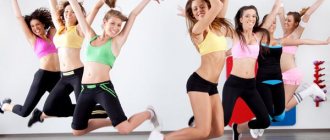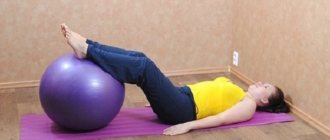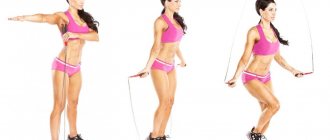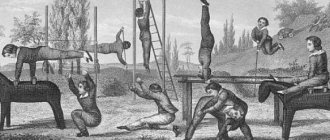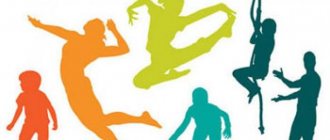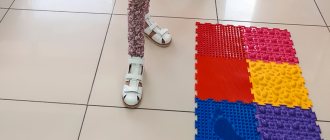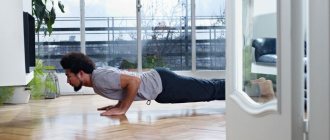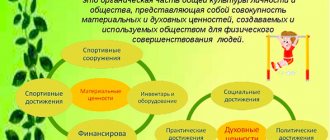To classify physical exercises means to logically present them as some ordered set, dividing them into groups according to certain characteristics.
As a means of physical education, physical exercises are classified in accordance with the characteristics that form their basis. For example, the classification of physical exercises based on their predominant impact on the development of physical qualities is widespread (L. P. Matveev, 1991). Let's look at this classification and several other classifications of physical exercise in more detail.
1. Classification of physical exercises according to their primary effect on the physical qualities of a person .
According to this classification, physical exercises are divided into four groups.
The first group is speed-strength exercises characterized by maximum intensity or power of effort (sprinting, jumping, athletics throwing, starting accelerations, etc.).
The second group is cyclic exercises with submaximal, high and moderate intensity (medium, long and ultra-long distances). This group includes: athletics running, race walking, swimming, skiing, skating, rowing, cycling, etc.).
The third group is complex coordination exercises that require the manifestation, mainly, of coordination abilities under the conditions of a strictly specified movement program (gymnastic and acrobatic exercises, diving, figure skating, synchronized swimming, etc.).
The fourth group is types of exercises that require complex manifestation of physical qualities in conditions of variable modes of motor activity, continuous changes in situations and forms of action. The fourth group is divided into two subgroups:
• Martial arts (all types of wrestling, boxing, fencing).
• Sports games (football, volleyball, basketball, hockey, etc.).
In the following classification, physical exercises are divided into groups according to the characteristics of the structure of movements.
2. Classification of physical exercises according to the structure of movements .
Muscle work during physical exercise can be dynamic and static. In some types of exercises the first predominates, in others the second.
Dynamic work can be cyclical, acyclic or mixed.
The cyclic type includes exercises in which movements are identical in structure and are stereotypically repeated one after another. For example: walking, running, cycling, swimming, rowing, etc. In walking and running, the repeating cycle is a double step.
The acyclic type includes movements consisting of separate, dissimilar motor acts performed in a certain sequence. For example: throwing athletics equipment, standing jump, feints in sports games, combinations of exercises in gymnastics, etc.
In exercises with a mixed nature of work, movements of a cyclic and acyclic nature are combined in one exercise. For example: running long and high jumps, hurdling, dribbling a ball in sports games followed by a feint or other acyclic movement.
With static forces, the working muscles are tense, and there is no movement in this joint. For example: maintaining a pose, hanging angle on a bar, gymnastic “bridge”, etc. To prevent injuries, you can use kinesio tape taping.
3. Classification of physical exercises according to their relative power . (exercises of maximum, submaximal, large and moderate power). Let's look at a table that gives a brief description of the above-mentioned relative power zones, into which exercises can be grouped by load intensity.
| Indicators. | Maximum power. | Submaximal power. | Great power. | Moderate power. |
| Exercise time. | From 3 to 20 seconds. | From 20 sec. up to 3 min. | From 3 to 30 min. | Over 30 min. |
| Using the example of competitive running. | From 10-20 to 200 meters. | From 200 m to 1500 m. | From 1.5 to 10 km. | Over 10 km. |
| Heart rate (bpm) | Not informative. | Over 180. | 160-180. | 140-160. |
| Ratio: O2 consumption to O2 demand. | 1: 10 | 1: 9; 1: 2 | 1: 1,8; 5: 6 | 9:10; 1:1 |
| Oxygen duty (l/min.) | Up to 20 | Up to 25 | 10-15 | Up to 4 |
| Lactic acid concentration (millimoles/liter). | 5-8 | 20 or more. | Until 8-10 | Up to 4 |
| Intensity zones. | 5th zone – anaerobic-alactate. | 4th zone – anaerobic-glycolytic. | 3rd zone – mixed aerobic-anaerobic. | 2nd zone – aerobic development. |
1st zone – aerobic – recovery (background loads: warm-up, cool-down, recovery exercises.
Section of the article: Theory and methodology of physical culture
What is the "daily dozen"
This is a simple workout that should be easy and fun. It develops flexibility, improves posture, muscle coordination and balance.
Camp argued that exercise has a positive effect on the functioning of internal organs, in particular the intestines, and also improves cognitive functions, improving brain function.
The Daily Dozen is suitable for any adult, but is especially useful for middle-aged people who experience some tightness in their bodies and sit most of the day.
About types of physical exercise
Physical exercises include exercises performed while doing some kind of work, and purely physical exercises. It is these latter that are meant here, for they are physical exercises, and are done only for the benefit obtained from them.
Physical exercises are different, namely: small or large, very strong and weak, fast or slow, or agile, consisting of sharp and fast [movements], there are also sluggish exercises. In addition, between each two extremes there are also moderate [types of exercise].
As for the types of physical exercises, these include: tug-of-war, fist fighting, archery, fast walking, javelin throwing, jumping [up] to some object to hang on it, hopping on one leg, fencing with a sword and a spear , horse riding, swinging with both arms, with the person rising on his toes and extending both arms forward and back, making quick movements. This is one of the quick exercises.
Smooth and easy exercises include swinging on swings and in cradles while standing, sitting and lying down; boating and boating. More powerful [exercises] include riding a horse, a camel, and [riding] in palanquins and carts.
Strong ones include exercises on the square, which consist in a person quickly moving across the square to the edge [of it] and then returning back without changing position, while each time he reduces the distance until he stops in the middle.
[Strong exercises] include fighting with one's own shadow, striking with the palms, jumping, striking with the tip of a spear, playing chōgan with a large and small ball, playing ball, wrestling, lifting stones, chasing and reining in a horse.
Struggle also has different types. One of the types is this: each of two men grabs the other’s belt with his hands and pulls him towards himself, while each of them strives to free himself from his opponent, but he does not let him go. Another view: one of the two [men] hugs the other with both arms, passing his right hand under the opponent’s right hand. and the left under the left. Then he presses it [to himself] and turns it over, while bending and straightening. [Wrestling] also includes reflecting with the chest or grabbing another’s neck and pulling down, or [the following techniques]: grabbing each other with their legs, tripping them, spreading the other’s legs with their legs, and similar techniques used by wrestlers.
Quick exercises include the following: quick change of places by two partners; continuous jumps back, then forward, and [the order can be] regular and disordered. This also includes an exercise with two large needles, which consists of the following: a person stands in a certain place and sticks two large needles into the ground on both sides at a distance of a fly fathom from each other. Then he turns to the needle on the right side and transfers it to the left side, and transfers the needle from the left side to the right, and tries to do all this as quickly as possible.
Sharp and fast exercises are done intermittently or together with easier exercises. It is necessary that there is variety in the exercises, and do not linger on one.
There are specific exercises for each member. As for the exercises of the arms and legs, they are known. And exercises of the chest and respiratory organs [are done as follows: a person] alternately gives a very low voice, then a high and medium one, while such organs as the mouth, uvula, tongue, and also the neck are exercised; In addition, the color [of the face] improves and the chest is cleansed. The exercises also include blowing and holding the breath, in which the whole body is exercised and all channels are expanded.
Giving a strong voice for a very long time is very dangerous because great strength [of the voice] requires inhaling a lot of air, which is dangerous, and duration [of the voice] requires exhaling a lot of air, which is also very dangerous. First you need to start with quiet reading aloud, then you need to gradually raise your voice, moreover, the duration of the loud and harsh voice should be moderate; there is a clear and great benefit to this. Increasing the duration of use of such [voice] is dangerous for persons in moderate health.
The exercises should be appropriate for each person. This type of light exercise, such as swinging, is suitable for persons weakened by fever, and for those who find it difficult to move and sit; [they are also useful] for those recovering and for those who have lost strength from eating hellebore and the like, as well as for those suffering from the disease of the abdominal obstruction. If you carefully [rock a person], he will fall asleep and the winds will dissolve within him. It is also useful against the consequences of head diseases such as absent-mindedness and forgetfulness; it stimulates the appetite and invigorates the nature.
Rocking on the bed is more suitable for persons suffering from three-day fever, mixed fever and mucous [fever]; Rocking is also suitable for those suffering from dropsy, gout and kidney disease.
So, as a result of rocking, bad juices are prepared for removal. At the same time, they pump strongly when [the juices] are strong, and weakly when [the juices] are weak. Riding in carts also has the same effect, but more powerful. Riding in a carriage, sitting backwards, is of great benefit for weak and clouded vision.
Riding on boats and vessels close to the shore is beneficial against leprosy, dropsy, sickness, cooling the stomach and swelling. If [the patient] gets sick from rocking and then calms down, then it is good for the stomach.
Sailing on ships on the open sea has a stronger effect on eradicating the mentioned diseases due to the fact that the soul [of the patient] experiences either joy or sadness.
As for the digestive organs, their exercise is subject to the physical exercises of the whole body. Visual exercise is done by looking closely at small objects, and from time to time casting quick glances at higher elevations. Hearing should be exercised by listening to soft sounds, and less often to strong sounds.
There are special exercises for each organ, which we will mention [below], in connection with maintaining the health of each organ separately in the Book of Specific [Diseases].
It is advisable for those engaged in physical exercise to protect their weak organs from strenuous movement.
[Exercises] should depend on [the condition of the organs]; for example, a person suffering from varicose veins in the legs should engage in types of exercise in which there is not much movement of the legs, but little; he must transfer all movements to the upper part of the body, such as the neck, head and arms, and so that the effect of the exercise on the legs comes from the upper part [of the body].
For a weak body, exercise should be light, and for a strong body, strong.
Know that each organ has its own special exercises.”
Physical activity is the most important factor in mental well-being
The health of the nation is largely determined by the attitude of society and the state towards physical culture and sports. One of the characteristic features of the culture of Ancient Greece was great attention to physical exercise, sports, various kinds of competitions, hardening and, in connection with this, personal hygiene. The Olympics and the Spartan system of education are widely known. Ancient Greek civilization gave the world the ideal of harmonious development of personality, both spiritual and physical.
Evidence of attitudes towards exercise can be found in a variety of sources.
Scripture on the Benefits of Physical Exercise
1 Timothy 4:8 “Bodily exercise has some benefit.”
First Timothy 4:8 does not downplay the importance of exercise for the body. Here the correct prioritization simply takes place: spiritual piety under any conditions is incomparably higher than physical exercise. As is clear from another biblical text, when one part of the body suffers, another part also suffers; the same is true about the opposite, i.e., about well-being and prosperity. With the growth of physical (bodily) well-being, spirituality can also increase if the latter receives due attention from the person.
Physical exercise is beneficial not only for this life, for the latter is not so important in an absolute sense, but also for eternal life. Physical exercise increases the sharpness of thinking and thereby contributes to spiritual growth.
A smart approach to choosing the type of exercise
Since the apostle Paul uses races to illustrate the core meaning of the Christian life, it is appropriate to use the same imagery to describe the purpose and structure of an exercise program based on running.
1 Cor. 9:24-27 “And therefore I do not run as if at the wrong thing, I do not fight as if only to beat the air.” (v. 26)
God gave man reason, including for self-control. The functioning of our body is determined by relevant laws. Therefore, in order to get the most out of your time and effort, you need to develop a realistic training program. Over the past 30 years, specialists, using laboratory research, have been able to determine quantitatively and qualitatively various indicators, including the intensity of physical activity, which provide the most beneficial effect on the cardiovascular system. As the biblical context above emphasizes, exercise should not be competitive. Instead of competing with each other, it makes more sense to measure your results against a certain standard. You need to compete with yourself, and in this way everyone will be able to achieve an individually determined level of physical fitness.
conclusions
If you ask those who regularly exercise what their benefits are, the answer is usually that such exercise improves their well-being. Improved well-being and a surge of energy provide an additional incentive to life. This is based on increasing the functional abilities of the heart and lungs. People who exercise regularly have other benefits as well.
They look better. Fitness involves increasing muscle tone, losing weight and reducing fat reserves. Trained people are more likely to monitor their diet and more easily get rid of bad habits such as smoking and drinking alcohol.
They are mentally healthier. Training gives a person self-confidence, vigor and improves his appearance. A trained person feels his health more acutely.
Trained people are less susceptible to stress and tension. They cope better with worry, anxiety, depression, anger and fear. They are not only able to relax more easily, but also know how to relieve tension with the help of certain exercises.
They have fewer health problems. Trained people are better able to resist illnesses, such as the common cold. They spend less time on sick leave and spend less money on treatment.
They sleep better. They fall asleep easier, sleep more soundly, and feel refreshed when they wake up. They need less time to sleep.
Systematic exercise does not guarantee a person's life extension, and, nevertheless, people who lead an active lifestyle can expect to live longer than those who spend their lives sitting. According to some physiologists, every hour of physical activity extends a person’s life by two or three hours. If so, then some people extend their life by as much as 5-10 years.
Spiritual priorities
Although the Kingdom of Heaven is not gained by eating and drinking, it can be lost by eating and drinking. Otherwise, gluttony and drunkenness would not be so strongly condemned. Instructions regarding the human diet, by the way, are contained in the Holy Scriptures.
Physical education should also not turn into an idol or take the place of more important things. This warning is contained, in particular, in the book of Psalms (chapter 146, vv. 10,11). It is important to set your priorities correctly. “And one should be done and the other should not be abandoned.”
The medieval scientist, philosopher and physician Avicenna attached great importance to physical exercise. The following portion from his book can serve as a guide to physical exercise today.
Warm-up
Before starting the main part of the workout (before moving on to exercises performed in the mode of continuous rhythmic movement), it is necessary to warm up for 5-10 minutes, that is, perform lighter physical exercises first. The type of exercises performed during the warm-up can be the same as during the main part; only their intensity differs. For example, slow walking is acceptable as a type of exercise performed as a warm-up before running. It allows the heart muscle and other muscles, as well as the lungs and joints, to adapt to increased physical activity. Additionally, warming up or warming up your muscles and joints helps prevent possible injuries. After warming up, you should do some light muscle stretching.
